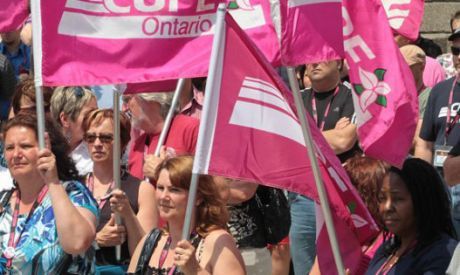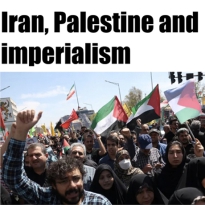Reports
You are here
CUPE Ontario prepares to take on Kathleen Wynne

October 6, 2014
Some 350 delegates from CUPE Ontario locals—consisting primarily of local executive members—met in the Toronto Sheraton Centre on Oct 5 for an “Emergency All Locals Leadership Meeting.”
The meeting was called for at the CUPE Ontario convention in May, with the purpose of preparing CUPE-O locals for the impending fight against the spending cuts and privatization of the Wynne government.
Had Tim Hudak won the provincial election, an emergency meeting would have been called sooner to address the threat of right-to-work. But it was recognized during the convention that in the event of a new mandate for Kathleen Wynne, workers in Ontario will continue to face austerity and will need to mount a renewed fightback.
The battle of 1,000 cuts
CUPE Ontario President, Fred Hahn, set the tone for the meeting in his opening remarks on the state of CUPE-O's readiness, and the challenges posed by the provincial Liberal government.
“We are not faced with one single challenge,” said Hahn, but a “battle of 1,000 cuts.” What we are up against, he argued, is a “ground war against working people”—a form of “disaster capitalism” which has been on the offensive for the last thirty years.
In what felt like a direct response to Jerry Dias's endorsement of Kathleen Wynne a day earlier, Hahn emphasized that “the Liberals are anything but progressive,” and much of the information that came later from the various sectoral chairs helped to provide evidence to that effect.
The spectre of Unifor's Good Jobs Summit hovered above in the Sheraton Centre, with a few members from the floor taking direct aim at “the revival of tripartism” (ie the willful co-operation between labour, business, and government) that was encouraged by several speakers at the Summit. In fact, the final resolution that was passed calls on CUPE-O to ensure that “our leaders, our Locals and our members are not coerced into tri-partite agreements or negotiations.”
Indeed, when CUPE National President, Paul Moist, spoke later in the day, he responded directly to Kathleen Wynne's speech at the Good Jobs Summit: “Kathleen Wynne should go stand up against US Steel, not lecture the labour movement about being too adversarial.”
Hahn's assessment of CUPE-O's strategic readiness was a sober one. Despite its ability to punch above its weight, he said, CUPE-O is not in fighting shape, and has not been in a position to defend our public services in a concrete way. The key question that we need to be asking is, “What's next?”—since the enemies of the labour movement are certainly asking that question, and are not taking any breaks.
The fightback that we need, he stressed, can not be a top-down exercise from the CUPE-O executive. Nor can it be provided through ads or commercials. Instead, CUPE members need to continue the work of member to member mobilization (exemplified by the Stand Up For Fairness campaign), and to build power from the bottom up.
Municipal elections
One of the central messages coming from the front was the necessity for locals to be engaging with, and providing support for, the upcoming municipal elections.
Sarah Joridison, the Campaigns Coordinator for CUPE Ontario, gave an overview of the resources CUPE-O has been committing to campaigns across the province. CUPE-O has members booked-off for municipal campaigns in roughly a dozen cities, including Thunder Bay, Sudbury, Windsor, Hamilton, Toronto, and Kingston, among others.
A few delegates from the municipal sector stressed that the upcoming elections were an opportunity for workers to elect their bosses. Electing progressive and labour friendly candidates, they said, helps to ensure that municipal workers will have more favourable bargaining conditions in the future.
However, there were a few disagreements over CUPE's current list of endorsements, with some delegates reporting that CUPE-endorsed candidates have not always acted in the interest of workers.
Building the General Strike?
In the afternoon, delegates debated and voted on a special resolution, and much will likely be made of the call for a “general strike” included in that resolution.
A delegate from the floor raised the general strike as an amendment to a line in the resolution calling for a “community day of action.” While his motivation for calling a general strike was compelling and genuine, there was little discussion of how such a general strike could be built, when it is supposed to occur, and why other workers would necessarily follow our lead.
Further, given the context where a significant minority of the labour movement has shifted their support to the Wynne Liberals, as well as the overall state of unpreparedness laid out (rather convincingly) by Fred Hahn earlier in the day, the amendment was hard to take seriously. So too was another amendment that called for scrapping any mention of pressuring politicians, proposing in its place a call to build a revolutionary workers' party.
While I agree with the need for such a party, this is not how one goes about building one.
The final language of the resolution reflects the haphazardness of the general strike amendment. It reads: “A plan of ongoing and escalating actions against cuts including consideration of a community day of action, where locals have built toward that kind of event, including a general strike.”
There was no debate on the amendment, and it passed with a slim majority. But this wasn't the first time in recent memory that activists in CUPE have relied on the resolutionary road to socialism.
At the CUPE Ontario convention in May, Resolution 76 called on CUPE Ontario to “Support and work with CUPE locals, councils, and members activists to build toward strike votes in support of a General Strike on May Day 2015.” Resolution 76 did not make it to the floor. But even if it had, and even if it had passed, it would not have brought us any closer to a general strike on May Day.
Both of these resolutions fail to correspond to the lived realities on the ground for workers in Ontario. The labour movement pulled off an impressive few months of mobilizing in the lead-up to the provincial election, but is nowhere near the stage of carrying out a general strike. These resolutions not only misread the current terrain, but also fail to understand the relationship between the bureaucracy and the rank-and-file. General strikes cannot be called into being from the top; there is no magic strike button that the labour leadership can press on a whim.
The fact that many labour activists are again talking about the need for a general strike is surely a positive sign. Socialists look forward to the day when the tactic of the general strike is put firmly back on the labour movement's agenda, and when discussing such a tactic has moved beyond empty slogans. But it can only be put back on the agenda through a mass upsurge of class struggle. A general strike cannot be willed into existence—if it could, we might as well be passing resolutions against capitalism itself.
At the CUPE-O leadership meeting, one could hear quite clearly the extent of the attacks coming down against workers in the public sector. In a breakout session for the Hamilton-Niagara region, delegates compiled a long list of the cuts, outsourcing, job losses through attrition, privatization, and reduction in full-time work that workers are experiencing in their locals.
They made clear the extent to which public sector workers are facing the sharp edge of austerity, and perhaps it is no wonder, then, why sections of leadership are turning to magic solutions—be they social media gimmicks, slick ads, or attempts to find the “general strike” button. These options seem much easier than the member-to-member mobilizing that helped us to defeat Hudak. But if we are to build a movement capable of taking on Wynne and pushing back against her agenda of cuts and privatization, we need to move beyond quick fixes and focus on building the power and confidence of rank-and-file members.
Section:










